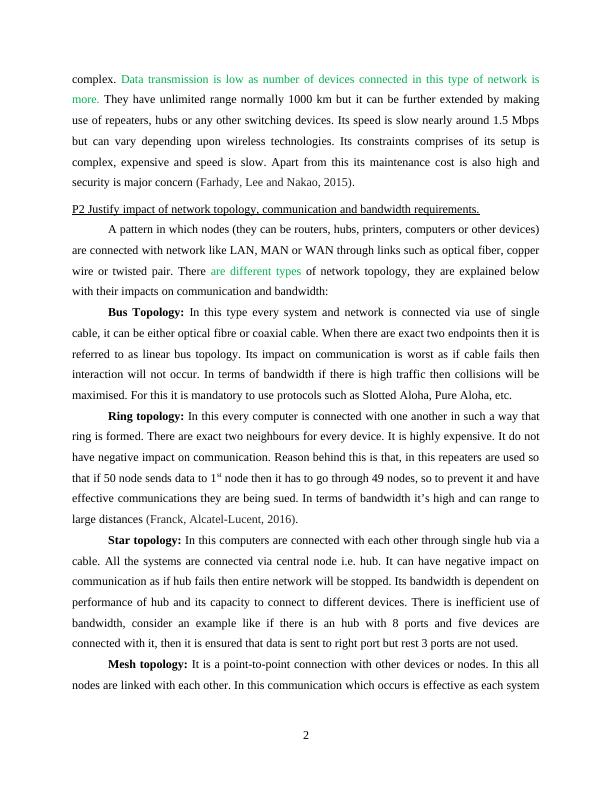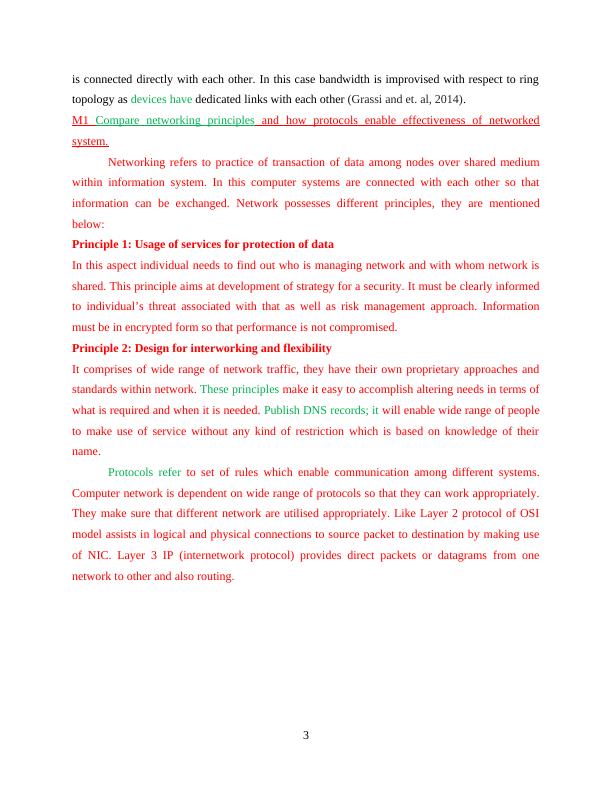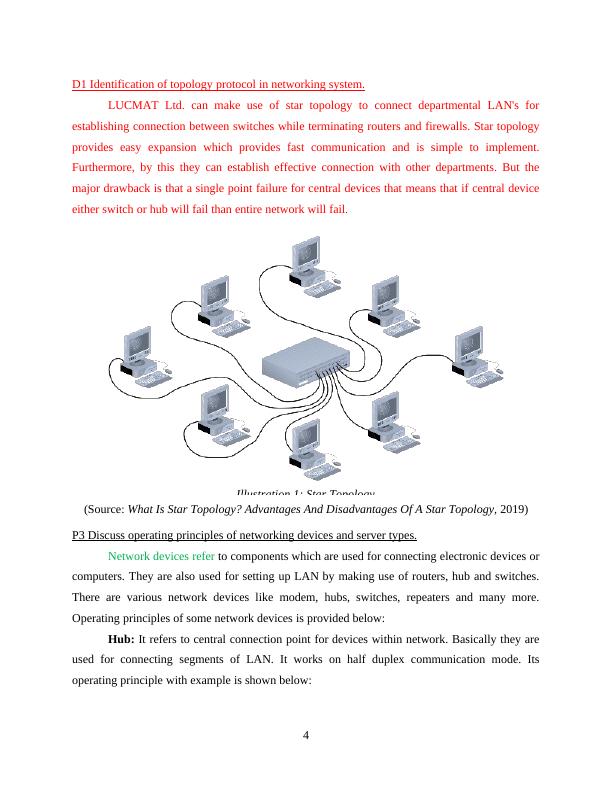(solved) Assignment on Networking
27 Pages5649 Words353 Views
Added on 2020-10-05
(solved) Assignment on Networking
Added on 2020-10-05
ShareRelated Documents
Networking

Table of ContentsINTRODUCTION...........................................................................................................................1P1 Discussion on constraints and benefits of network types and standards................................1P2 Justify impact of network topology, communication and bandwidth requirements...............2P3 Discuss operating principles of networking devices and server types...................................3P4 Discuss interdependence of hardware workstation with networking software......................6P5 Design of networked system to meet specifications of LUCMAT Ltd..................................7P6 Test evaluate design so that requirements can be met and analyse feedback from user........8P8 Documentation and analysis of test results against expected results......................................9CONCLUSION..............................................................................................................................10REFERENCES..............................................................................................................................11

INTRODUCTIONIn the present world, word networking define the accurate and easy exchange of ideasand useful information between large number of people those share common profession and havespecial interest basically in an informal social setting (Bernardos and et. al, 2014). In technicalword, computer networking is referred to the connection of number of devices in appropriatemanner that support to share the effective information and resources of software. This report isbased on LUCMAT Ltd which is an organisation which is opting to use LAN in their workingwith IP address 192.168.10.0/24. This report consists of network types and standards, networktopology, their impact and operating principles. Furthermore, there interdependence is isdiscussed and network design is provided with feedback from employees related to its working.P1 Elaborate constraints and benefits of network types as well as standards.Network refers to accumulation of two or more devices through which communicationcan be carried out. These devices and systems are connected with each other by usage of wirelessor physical connections. Communication can occur by usage of emails, shared devices likeprinters and shared storage devices. There are different network types but mostly LAN, MANand WAN are used for carrying out communication among organisations.Local Area Network (LAN): It is restricted to specific areas like office, campus orhome. They are generally used as they are easy to implement and troubleshoot. It can be assimple as connecting two computers for sharing files and storage space among them. They areconnected via Ethernet or Wi-Fi. There coverage area is small nearby 2500 metres or 2 mileswith speed which ranges from 10-1000 Mbps. The major constraint of LAN is its high setup cost,data security threat, maintenance cost and limited area coverage.Metropolitan Area Network (MAN): It is a large number which is used to organisationswhich are present in same city. They are installed by usage of common carrier; they can be fiberoptic cable or twisted pair. They furnish fast communication by usage of high-speed carriers.They cover up to 200 km or 100 miles and they have high speed of 100 Mbps. Its constraints arethat in case of wired network, lots of wire or cable is required and it is complex to secure systemfrom intruders due to graphical regions (De-Marcos and et. al, 2014). Wide Area Network (WAN): It spans over large locality and connects with othercountries. They can be either private or public. Maintenance and designing of such systems is1

complex. Data transmission is low as number of devices connected in this type of network ismore. They have unlimited range normally 1000 km but it can be further extended by makinguse of repeaters, hubs or any other switching devices. Its speed is slow nearly around 1.5 Mbpsbut can vary depending upon wireless technologies. Its constraints comprises of its setup iscomplex, expensive and speed is slow. Apart from this its maintenance cost is also high andsecurity is major concern (Farhady, Lee and Nakao, 2015).P2 Justify impact of network topology, communication and bandwidth requirements.A pattern in which nodes (they can be routers, hubs, printers, computers or other devices)are connected with network like LAN, MAN or WAN through links such as optical fiber, copperwire or twisted pair. There are different types of network topology, they are explained belowwith their impacts on communication and bandwidth:Bus Topology: In this type every system and network is connected via use of singlecable, it can be either optical fibre or coaxial cable. When there are exact two endpoints then it isreferred to as linear bus topology. Its impact on communication is worst as if cable fails theninteraction will not occur. In terms of bandwidth if there is high traffic then collisions will bemaximised. For this it is mandatory to use protocols such as Slotted Aloha, Pure Aloha, etc. Ring topology: In this every computer is connected with one another in such a way thatring is formed. There are exact two neighbours for every device. It is highly expensive. It do nothave negative impact on communication. Reason behind this is that, in this repeaters are used sothat if 50 node sends data to 1st node then it has to go through 49 nodes, so to prevent it and haveeffective communications they are being sued. In terms of bandwidth it’s high and can range tolarge distances (Franck, Alcatel-Lucent, 2016).Star topology: In this computers are connected with each other through single hub via acable. All the systems are connected via central node i.e. hub. It can have negative impact oncommunication as if hub fails then entire network will be stopped. Its bandwidth is dependent onperformance of hub and its capacity to connect to different devices. There is inefficient use ofbandwidth, consider an example like if there is an hub with 8 ports and five devices areconnected with it, then it is ensured that data is sent to right port but rest 3 ports are not used.Mesh topology: It is a point-to-point connection with other devices or nodes. In this allnodes are linked with each other. In this communication which occurs is effective as each system2

is connected directly with each other. In this case bandwidth is improvised with respect to ringtopology as devices have dedicated links with each other (Grassi and et. al, 2014). M1 Compare networking principles and how protocols enable effectiveness of networkedsystem.Networking refers to practice of transaction of data among nodes over shared mediumwithin information system. In this computer systems are connected with each other so thatinformation can be exchanged. Network possesses different principles, they are mentionedbelow: Principle 1: Usage of services for protection of data In this aspect individual needs to find out who is managing network and with whom network isshared. This principle aims at development of strategy for a security. It must be clearly informedto individual’s threat associated with that as well as risk management approach. Informationmust be in encrypted form so that performance is not compromised.Principle 2: Design for interworking and flexibilityIt comprises of wide range of network traffic, they have their own proprietary approaches andstandards within network. These principles make it easy to accomplish altering needs in terms ofwhat is required and when it is needed. Publish DNS records; it will enable wide range of peopleto make use of service without any kind of restriction which is based on knowledge of theirname. Protocols refer to set of rules which enable communication among different systems.Computer network is dependent on wide range of protocols so that they can work appropriately.They make sure that different network are utilised appropriately. Like Layer 2 protocol of OSImodel assists in logical and physical connections to source packet to destination by making useof NIC. Layer 3 IP (internetwork protocol) provides direct packets or datagrams from onenetwork to other and also routing. 3

D1 Identification of topology protocol in networking system.LUCMAT Ltd. can make use of star topology to connect departmental LAN's forestablishing connection between switches while terminating routers and firewalls. Star topologyprovides easy expansion which provides fast communication and is simple to implement.Furthermore, by this they can establish effective connection with other departments. But themajor drawback is that a single point failure for central devices that means that if central deviceeither switch or hub will fail than entire network will fail.(Source: What Is Star Topology? Advantages And Disadvantages Of A Star Topology, 2019)P3 Discuss operating principles of networking devices and server types.Network devices refer to components which are used for connecting electronic devices orcomputers. They are also used for setting up LAN by making use of routers, hub and switches.There are various network devices like modem, hubs, switches, repeaters and many more.Operating principles of some network devices is provided below:Hub: It refers to central connection point for devices within network. Basically they areused for connecting segments of LAN. It works on half duplex communication mode. Itsoperating principle with example is shown below:4Illustration 1: Star Topology

End of preview
Want to access all the pages? Upload your documents or become a member.
Related Documents
Networking on Lucmat Ltd Assignmentlg...
|16
|4701
|253
Benefits and Constraints of Different Network Typeslg...
|22
|5141
|7484
Unit 2 : Networking Infrastructure - Assignmentlg...
|26
|8992
|888
Evaluation of Wireless Networkslg...
|11
|4299
|214
Network Principles and Protocolslg...
|13
|3704
|69
Network Information Systemslg...
|17
|2805
|1
